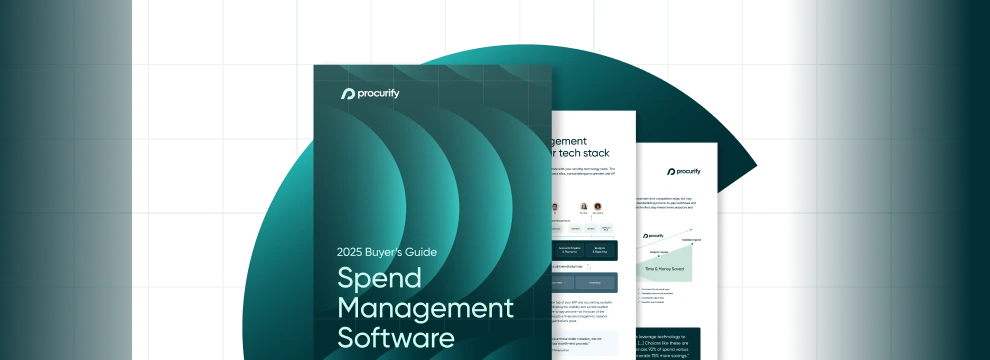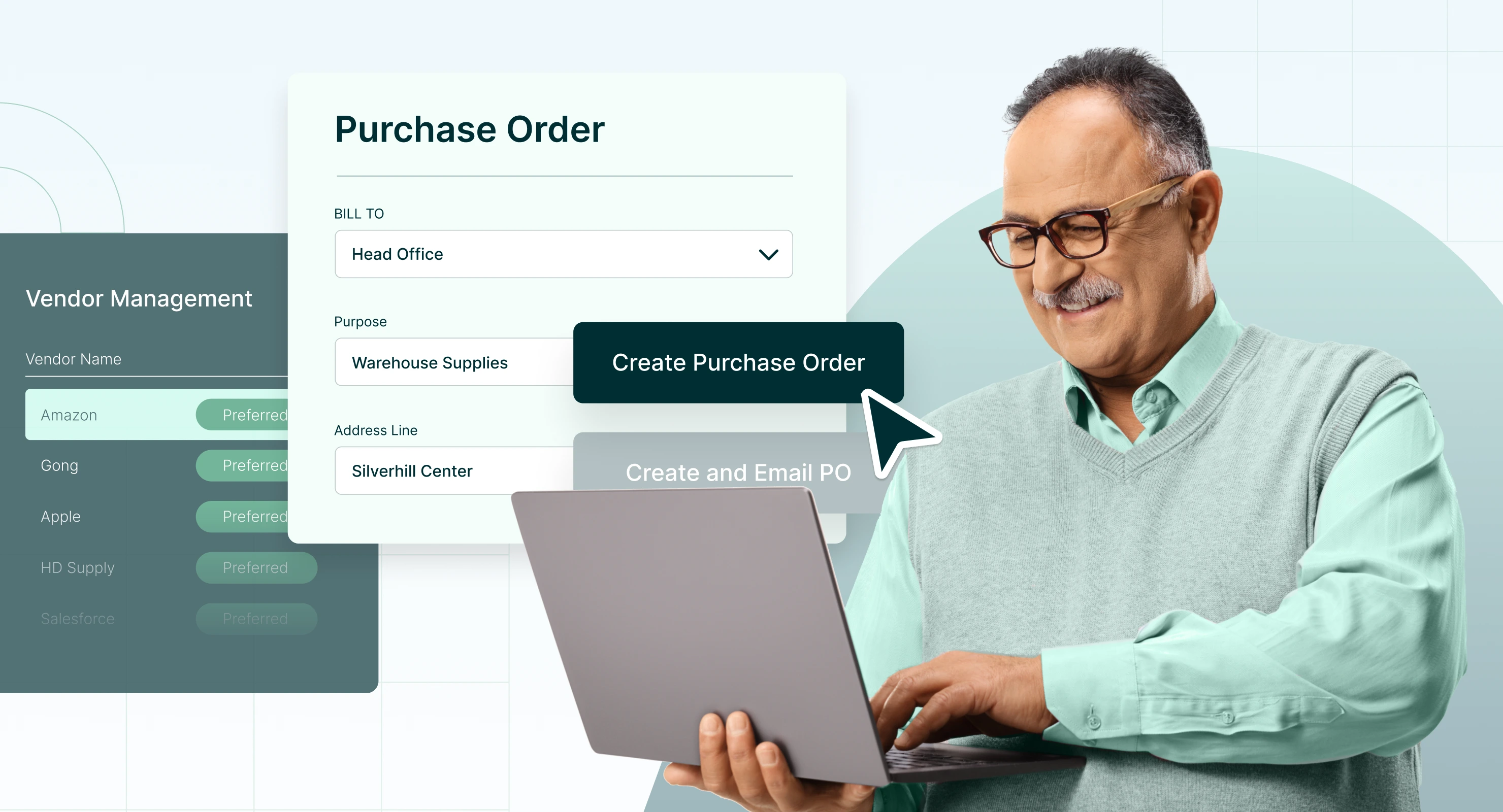
Understanding the Procurement Process: A Comprehensive Guide for 2024
The procurement process, often perceived as a straightforward sequence of events, entails much more than just locating, purchasing, receiving, and paying for goods. It’s a multifaceted business function comprising several stages, each offering opportunities for optimization.
In recent years, the digital transformation into procurement software has revolutionized procurement, enhancing cost efficiency, enabling real-time data analysis, and streamlining operations. According to the 2021 Deloitte Global Chief Procurement Officer Survey, operational efficiency remains a top priority for CPOs, with a significant emphasis on cost reduction and embracing digital transformation.
This article delves into the intricacies of the procurement process, highlighting how refining your procurement strategy can significantly influence your organization’s efficiency, productivity, and overall profitability.
Understanding procurement
At its essence, procurement is the process through which organizations identify, acquire, and manage the goods and services necessary to run their operations. This encompasses everything from office supplies to manufacturing components, and it plays a pivotal role in ensuring that a business operates smoothly and efficiently.
The procurement process involves several key steps: identifying needs, sourcing suppliers, negotiating contracts, and managing supplier relationships. Effective procurement goes beyond mere purchasing to become a strategic function focused on optimizing costs, ensuring quality, and managing risk within the supply chain. Read more about the differences between procurement and purchasing.
As we delve deeper into the nuances of procurement, it’s clear that this function is not just about buying at the lowest price. It’s about finding the best value for the organization, considering factors such as total cost of ownership, supplier performance, and the alignment of purchases with corporate goals and values.
For those looking to explore this topic further, a dedicated article on “What is Procurement?” will provide comprehensive insights into all aspects of procurement, its importance within modern organizations, and best practices for procurement professionals.
Types of procurement
Understanding the different types of procurement helps organizations optimize their purchasing strategies based on their specific needs. Procurement can be categorized into three main types:
1. Direct procurement
Direct procurement involves acquiring raw materials, components, or goods directly used in production. This type of procurement is crucial for manufacturers, retailers, and businesses that produce goods. Efficient direct procurement ensures a smooth supply chain and cost-effective production.
Example: A car manufacturer purchasing steel, tires, and engines for vehicle production engages in direct procurement.
2. Indirect procurement
Indirect procurement refers to purchasing goods and services that support day-to-day business operations but are not directly related to the final product. These include office supplies, software subscriptions, and maintenance services.
Example: A company subscribing to an employee training platform or purchasing office furniture falls under indirect procurement.
3. Services procurement
Services procurement focuses on obtaining specialized services from third-party providers. These may include consulting, IT support, legal services, and outsourced labor. Managing services procurement effectively helps organizations maintain efficiency without the need for in-house resources.
Example: A business hiring a marketing agency for an advertising campaign engages in services procurement.
Why is the Procurement Process Necessary?
The procurement process is fundamental for ensuring that an organization operates efficiently and effectively. It’s necessary for several key reasons:
-
Cost Efficiency: A structured procurement process enables organizations to minimize costs by comparing suppliers, negotiating prices, and achieving favorable terms. This cost efficiency directly impacts the organization’s profitability.
-
Quality Assurance: It ensures that the goods and services purchased meet specific quality standards, which is crucial for maintaining operational excellence and customer satisfaction.
-
Supply Chain Reliability: By establishing strong relationships with suppliers and conducting thorough market research, the procurement process enhances supply chain reliability, ensuring timely delivery of goods and services.
-
Compliance and Risk Management: A formal procurement process helps in adhering to laws and regulations, while also identifying and mitigating risks associated with supply chain disruptions, price volatility, and supplier performance.
-
Strategic Alignment: It aligns purchasing decisions with the organization’s strategic objectives, such as sustainability goals, innovation, or market expansion, ensuring that every procurement activity supports broader business aims.
-
Innovation and Improvement: Through engagement with suppliers and industry analysis, the procurement process can introduce new technologies and practices that drive organizational improvement and competitive advantage.
In essence, the procurement process is necessary for optimizing spending, ensuring quality and reliability, managing risks, aligning with strategic goals, and fostering innovation within the organization. It’s not just about buying goods and services; it’s a strategic function that supports the overall success of the organization.
What is the Procurement Process, and How Long Does it Take?
The procurement process encompasses the entire method by which organizations acquire goods and services to meet their needs. This process is fundamental to business operations, ensuring that companies can secure the necessary resources efficiently and cost-effectively. The duration of the procurement process varies significantly, depending on several factors such as the complexity of the requirements, the procurement platforms being utilised, the procurement method used, and the responsiveness of suppliers. Here’s a straightforward breakdown of the procurement process:
-
Needs Identification: The process starts when a need for goods or services arises within the organization that cannot be fulfilled internally.
-
Specification of Requirements: Detailed specifications for the needed goods or services are developed, outlining desired quality, quantity, and timelines.
-
Supplier Identification: Potential suppliers capable of providing the required goods or services are identified through research or existing relationships.
-
Solicitation of Bids/Proposals: The organization invites bids or proposals from suppliers through a request for quotation (RFQ) or request for proposal (RFP).
-
Evaluation and Selection: Submitted bids or proposals are evaluated against criteria such as price, quality, and service delivery capability to select the best supplier.
-
Contract Negotiation: Negotiations on price, terms, and conditions are conducted with the selected supplier, culminating in a signed contract.
-
Purchase and Order Management: A formal purchase order is issued to the supplier, who then acknowledges and confirms the details of the order.
-
Goods/Services Delivery: Upon delivery, the goods or services are inspected for compliance with the procurement specifications.
-
Payment Processing: After verifying that the goods or services meet requirements, an invoice is processed and payment is made to the supplier.
-
Record Keeping and Documentation: All procurement documents, including contracts, orders, and payment records, are properly documented for audit trails and compliance.
-
Supplier Performance Evaluation: After the procurement cycle completes, the supplier’s performance is evaluated for future reference.
The length of this process can range from a few weeks for simple purchases to several months or even a year for more complex acquisitions. Factors influencing the duration include the procurement scale, the need for detailed specifications, and the extent of negotiation required.
How Do We Measure the Effectiveness of the Procurement Process?
Measuring the effectiveness of the procurement process is crucial for understanding its efficiency, cost-effectiveness, and overall contribution to the organization’s goals. Key performance indicators (KPIs) and metrics are used to evaluate various aspects of procurement activities. Here are some of the most common metrics:
-
Cost Savings: This metric measures the reduction in costs achieved through procurement activities compared to previous periods or benchmarked standards. It reflects the procurement team’s ability to negotiate favorable terms and leverage economies of scale.
-
Spend Under Management: It indicates the percentage of the organization’s total spend that is actively managed by the procurement team. Higher percentages suggest better control and optimization of expenditures.
-
Supplier On-Time Delivery Rate: This KPI tracks the percentage of orders delivered on time by suppliers. It’s crucial for assessing supply chain reliability and the efficiency of supplier management processes.
-
Quality of Goods and Services Received: Evaluating the quality of purchased goods and services against specifications helps determine the effectiveness of the procurement process in ensuring supplier compliance and meeting the organization’s standards.
-
Procurement Cycle Time: The time taken from the identification of a need to the delivery of goods and services measures the efficiency of the procurement process. Shorter cycle times indicate a more efficient procurement operation.
-
Contract Compliance Rate: This metric assesses how well suppliers adhere to the terms and conditions of their contracts, including pricing, delivery schedules, and quality specifications.
-
Customer Satisfaction: Internal customer satisfaction with the procurement process, from request to receipt of goods or services, indicates the process’s responsiveness and effectiveness in meeting organizational needs.
-
Return on Investment (ROI): Calculating the ROI of procurement activities, by comparing the benefits gained (cost savings, improved quality, etc.) against the costs incurred, provides insight into the overall value generated by the procurement function.
These metrics offer a comprehensive view of the procurement process’s performance, highlighting areas of strength and identifying opportunities for improvement. Regularly monitoring these KPIs helps procurement teams optimize their strategies, processes, and relationships with suppliers, ultimately contributing to the organization’s success. Good procurement softwares can assist this process dramatically.
Compliance and risk management in procurement
Ensuring compliance and managing risks effectively are essential to avoiding legal issues, financial losses, and reputational damage. By implementing strong policies and proactive strategies, organizations can safeguard their procurement processes while promoting ethical business practices.
Ensuring compliance with regulations
Organizations must adhere to local and international procurement regulations, including anti-corruption laws and ethical sourcing standards. Non-compliance can lead to fines, legal consequences, and damage to business credibility. Regularly auditing procurement processes ensures adherence to compliance policies, allowing companies to identify gaps before they become major issues.
Identifying and mitigating risks
Procurement risks, such as supplier failures, market volatility, and cybersecurity threats, can disrupt operations and impact financial stability. Businesses should conduct regular risk assessments and develop mitigation strategies to ensure continuity. For example, a company that sources materials from multiple suppliers minimizes the risk of supply chain disruptions caused by geopolitical instability, ensuring steady production even if one supplier faces challenges.
Ethical procurement practices
Sustainable and ethical procurement is becoming a priority for businesses looking to enhance corporate responsibility and meet consumer expectations. Companies should focus on fair trade, environmentally friendly sourcing, and labor rights compliance. For instance, brands like Patagonia ensure ethical procurement by partnering with sustainable and certified suppliers, reinforcing their commitment to social and environmental responsibility while maintaining product quality.
How Can We Achieve Sustainability in the Procurement Process?
Achieving sustainability in the procurement process means making purchasing decisions that not only meet the organization’s needs but also consider environmental impact, social responsibility, and economic benefits over the long term. Here are key strategies to integrate sustainability into procurement:
-
Sustainable Sourcing: Prioritize suppliers who demonstrate environmentally friendly practices, such as using renewable resources, minimizing waste, and reducing carbon emissions. Sustainable sourcing also involves considering the lifecycle impact of products and services, from production to disposal.
-
Supplier Assessments: Conduct thorough assessments of suppliers’ sustainability practices, including their labor standards, environmental policies, and corporate social responsibility initiatives. This can be achieved through audits, certifications, and sustainability scorecards.
-
Incorporate Sustainability Criteria in Procurement Policies: Revise procurement policies to include sustainability as a core criterion alongside cost, quality, and delivery. This ensures that procurement decisions are made with a comprehensive view of value that includes environmental and social factors.
-
Collaborate with Suppliers: Work closely with suppliers to improve sustainability practices. Collaboration can lead to innovation in sustainable products and processes, as well as joint initiatives that contribute to broader sustainability goals.
-
Train Procurement Staff: Ensure that procurement teams are educated on sustainability issues, policies, and practices. Training should cover how to assess sustainability when selecting suppliers and products, and how to negotiate contracts that include sustainability criteria.
-
Use Ecolabels and Certifications: Look for products and services that are certified by reputable sustainability standards and ecolabels. These certifications can serve as a guide for making more sustainable procurement decisions.
-
Monitor and Report on Sustainability Performance: Implement systems to track and report on sustainability metrics related to procurement, such as carbon footprint reduction, waste minimization, and social impact. This transparency helps to hold the organization accountable and showcases its commitment to sustainability.
-
Engage Stakeholders: Involve stakeholders, including employees, customers, and community members, in sustainability initiatives. Their feedback and participation can enhance the effectiveness of sustainable procurement practices.
By integrating these strategies into the procurement process, organizations can significantly contribute to environmental conservation, social equity, and economic viability, ensuring a positive impact for current and future generations.
Enhancing the procurement process in 2024
As we look towards 2024, the procurement process is set to evolve with the adoption of new technologies and methodologies. Here are several key areas where enhancements are anticipated:
-
Digital Transformation: Advanced digital tools, including AI and machine learning, will further automate procurement tasks, from supplier selection to contract management. Procurement automation will speed up processes, reduce human error, and enable data-driven decisions.
-
Data Analytics and Insights: Enhanced analytics capabilities will allow procurement teams to gain deeper insights into spending patterns, supplier performance, and market trends. This will support more strategic sourcing and risk management.
-
Sustainable and Ethical Procurement: There will be a stronger focus on sustainability, with organizations prioritizing suppliers that adhere to environmentally friendly practices and ethical labor standards. This shift will be driven by both regulatory requirements and consumer demand.
-
Supply Chain Resilience: Building resilient supply chains will be critical, especially in light of recent global disruptions. Procurement processes will prioritize flexibility, diversification of supply sources, and closer collaboration with key suppliers.
-
Collaborative Technologies: The use of collaborative platforms will enhance communication and partnership between procurement teams and suppliers. These technologies will facilitate real-time updates, joint problem-solving, and innovation.
-
Enhanced Skills and Training: As procurement becomes more strategic and technologically driven, investing in skill development and training for procurement professionals will be essential. Areas of focus will include data analysis, sustainability, and negotiation strategies.
-
Integration of ESG Criteria: Environmental, Social, and Governance (ESG) criteria will be integrated into procurement decisions, reflecting a holistic approach to value that includes social and environmental outcomes alongside economic benefits.
By embracing these enhancements, the procurement process in 2024 will become more efficient, sustainable, and aligned with broader organizational goals, driving significant value beyond cost savings.
Procurement best practices
To enhance efficiency, reduce costs, and improve supplier relationships, organizations should adopt best practices in procurement:
1. Establish a unified data core
Maintaining a centralized procurement database is essential for tracking suppliers, contracts, and spending. By consolidating procurement data, companies gain insights into purchasing patterns and can negotiate better deals.
Implementing procurement software that integrates with accounting and inventory systems ensures seamless data sharing and more accurate financial oversight.
2. Automate manual processes
Automating manual procurement processes reduces errors, inefficiencies, and delays. E-procurement tools streamline purchase requests, approvals, and supplier communication, minimizing administrative burdens. For instance, automating purchase order approvals speeds up procurement cycles and prevents bottlenecks, ensuring orders are processed without unnecessary delays.
3. Improve supplier collaboration
Strong supplier relationships lead to better pricing, improved product quality, and reduced supply chain risks. Establishing transparent communication, conducting regular performance reviews, and fostering long-term partnerships help build trust and reliability.
Companies that engage suppliers in product development often experience increased innovation and cost savings, creating a mutually beneficial relationship that drives business success.
Procurement optimization offers a net positive ROI, every time
Procurement optimization is the strategic improvement of procurement activities to maximize efficiency, reduce costs, and enhance value to the organization. This process consistently delivers a net positive return on investment (ROI) by achieving several key outcomes:
-
Cost Reduction: Streamlining procurement processes and leveraging technology for automation and better supplier management leads to significant cost savings. Negotiating better terms and utilizing strategic sourcing also contribute to reduced expenses.
-
Increased Efficiency: Optimization improves the procurement cycle’s speed and accuracy, reducing time spent on manual tasks and enabling teams to focus on strategic activities. This increased efficiency translates into lower operational costs and faster project completion times.
-
Risk Mitigation: By implementing comprehensive risk management strategies, including diversifying suppliers and conducting thorough market analysis, organizations can avoid costly disruptions and ensure supply chain resilience.
-
Enhanced Quality and Innovation: Optimized procurement processes facilitate closer collaboration with suppliers, driving improvements in product quality and access to innovative solutions that can provide a competitive edge.
-
Sustainability and Social Responsibility: Incorporating sustainability criteria into procurement decisions helps organizations meet regulatory requirements and consumer expectations for ethical and environmental stewardship, potentially opening up new markets and customer segments.
-
Improved Supplier Relationships: Strategic supplier management and collaborative partnerships result in better service levels, reliability, and opportunities for cost savings and innovation.
Each of these outcomes contributes to a stronger, more competitive organization. The initial investment in procurement optimization—whether in technology, training, or process reengineering—yields dividends in cost savings, operational efficiency, and enhanced strategic value. Thus, every dollar spent on optimizing the procurement function is an investment in the organization’s future success and sustainability.
Conclusion
As we navigate through the complexities of the modern business landscape, the role of the procurement process and procurement softwares has never been more critical. The evolution of procurement in 2024 emphasizes not just the importance of cost savings and operational efficiency but also the necessity of adaptability, sustainability, and strategic foresight. By embracing digital transformation, focusing on sustainability, and investing in skills development, organizations can ensure that their procurement processes are not only efficient but also aligned with broader business objectives and global trends.
The drive towards procurement optimization, underscored by a consistent net positive ROI, highlights the undeniable value of refining procurement strategies. This optimization is not merely about reducing costs or streamlining operations; it’s about enhancing the overall value proposition of the organization. Through strategic sourcing, risk management, and the integration of sustainability, the procurement function can contribute significantly to organizational resilience, competitive advantage, and long-term success.
As we look to the future, the procurement process will undoubtedly continue to evolve. However, the principles of strategic procurement—focusing on efficiency, innovation, and sustainability—will remain paramount. Organizations that recognize and act on these principles will be well-positioned to navigate the challenges and opportunities of 2024 and beyond, ensuring their success in a rapidly changing world.

2025 Procurement Benchmark Report
Powered by $20B+ in proprietary data you won’t find anywhere else.




